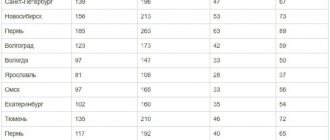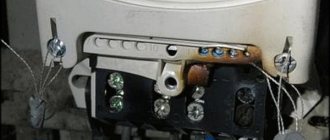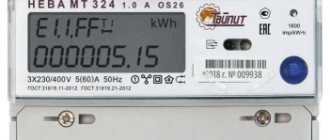The issue of paying for utility services is very acute for Russians, since their cost is often disproportionate to their earnings. Citizens try to save on everything, and one of these ways is to install an ODPU MKD (apartment building). The fact is that installing metering devices only in your apartment does not guarantee that additional amounts will not be charged in the receipt for paying for additional needs of the entire house, but a common meter will certainly reduce them. In addition, according to the government decree on charging utility bills, such devices are required to be in every apartment building. Residents who do not have a common house meter in their home must pay for the services provided at an inflated rate, determined in accordance with a coefficient of 1.6 to the standards. This is also a significant motivation to install ODPU.
What it is?
The abbreviation stands for “common house metering devices.” These devices are counters of various resources supplied immediately to the entire house, or more precisely, the entrance. The device determines the total energy consumption from all living residents and is also a distribution device.
Despite the fact that the installation of ODPU in a residential building has been mandatory by law for more than 5 years, not all citizens still have such devices in their homes.
Insulation measures
In a good way, you need to start a new life with the meter, while simultaneously carrying out insulation measures. Builders will most accurately identify the sources of heat leaks. They can also be found among the residents. Thus, reforming the energy accounting system can become an indirect reason for accounting in the house not only water, electricity, gas, heat, but also professional personnel living nearby. And the climate in a building can be changed in several ways:
- sealing cracks and crevices in walls and windows;
- hanging springs on the front door;
- laying insulation in the attic;
- by gluing seals on the entrance and attic doors.
Even in non-residential premises, hot water supply pipes can be wrapped with insulation or rags, which each house throws into trash cans. These places are usually heated only by pipes with hot contents. Then the water in some places may become noticeably hot for the first time, and in others it will simply result in savings in the quantities consumed.
Varieties
Devices for metering the consumption of common resources are usually installed in the basements or utility rooms of the building. They are produced separately for metering electricity, hot and cold water and thermal energy. After installation and startup, access to the devices from residents is blocked so that they cannot damage the equipment or change its readings.
To account for water consumption, separate devices are installed for cold and hot water. In addition to the standard meter, you can add a special sensor that determines the temperature of the supplied water and calculates its cost according to reality. That is, if insufficiently heated liquid flows through the hot water pipe, the meter will identify it as cold and charge residents a completely different payment.
Installing an ODPU for thermal energy allows you to seriously save consumed resources during the heating season.
To do this, you can use ultrasonic, tachometer, vortex or electromagnetic devices. Which ones to choose for a particular entrance are decided solely by the residents themselves.
To take into account the total energy consumption, the simplest single-tariff and multi-tariff devices are offered for installation. The latter allow you to save much more, since at different times of the day they calculate the cost of the resource at different prices. Today this is the most popular option. The essence of their work is that at night there is a minimum tariff for electricity, in the daytime it is slightly higher, and reaches its maximum during peak hours in the morning and evening. Of course, such a device will cost a pretty penny, but it will pay for itself very quickly. Installation of ODPU electricity is also carried out by a hired company of the choice of the residents themselves.
Additional services
Companies that install general metering devices for homes also offer their customers additional services. In addition to subsequent maintenance of running devices, companies install additional devices that contribute to even greater savings for a fee. These include a special unit for automatically adjusting the heating system and a device that monitors electricity consumption.
All residents have the right to choose the “complete set” of their equipment themselves and can agree to auxiliary devices or purchase devices without additional adjustment elements.
Device functions
The authorities require the installation of common resource meters in apartment buildings, since such devices make it possible to identify the real consumption of resources. For example, if only one citizen is registered in an apartment, then tariffs are calculated on him alone, but in fact a whole family lives in the apartment, which significantly increases the real expense.
The benefit of installing an ODPU (as described above) is also determined for residents who have individual meters for metering consumed resources in their apartments. Experts believe that individual meters are generally ineffective without installing common ones. This is justified by the fact that the presence of both individual and general metering devices helps:
- detect resource leaks in a timely manner;
- improve the payment formula;
- correctly analyze pressure, temperature and other parameters of supplied resources;
- correctly determine who exactly bears the losses in case of system violations.
In addition to this benefit for the management company, residents with individual meters in their apartments also have an advantage in installing ODPU. The fact is that their presence does not mean that the receipt will not contain a line of expenses for general house needs, which represents the expenditure of resources on servicing the elevator, playgrounds, basements and staircases. Ideally, this item should not exceed 2% of the amount of individual consumption, but in fact, all resources consumed by the entrance in excess of meter readings are taken into account here, including due to any leaks in the system.
It helps to normalize this column and correctly determine the location of the leak by installing the ODPU. What is this ability? It’s just that all leaks on the main line will no longer be included in the payment. The device records only those resources that actually entered the house. Of course, leaks may already be inside the house itself, and there are still enough reasons to raise the tariff, but the presence of such a device allows you to significantly reduce costs and is the first step towards savings.
Progress in PU production
Now you can install a pulse counter with remote radio transmission of information. Such a device eliminates visits from an inspector to take readings and prevents abuse by residents. Payment for data removal is not provided for by any documents, but must occur in the presence of a representative of the owners and users of the premises.
Another useful feature of metering devices: there are meters that count water with a temperature of at least 40 ° C as hot. Well, and the thermostats mentioned above on communal and individual heat meters.
Installation approval
The decision to install ODPU thermal energy and other resources supplied to the house must be made based on the results of a vote of all residents. In this case, it is necessary to draw up minutes of the meeting. If the residents themselves do not show any initiative, the organization itself can decide on the need to install ODPU forcibly through the court, since the law obliges absolutely everyone without exception to install it.
The management company today is not obliged to notify its residents about the planned installation of devices, since this is its legal responsibility. The Criminal Code does not bear any punishment for not warning owners about this. Among its responsibilities to residents today is an annual awareness-raising of new energy-saving options to residents.
Companies that supply resources to the home can also be required to install ODPU.
Who pays?
One of the main questions today: who should pay for the installation of ODPU? It is not controversial and has no exceptions. Federal law obliges owners to fully finance the installation of common household meters. The only step forward for homeowners is the possibility of installment payment for 5 years, that is, 60 equal payments, which will be made along with payment according to the receipt for utilities. If financially possible, owners can pay for everything at once in one payment after installing the devices or even before their installation begins.
Sometimes installation fees can be deducted from home repair and maintenance expenses, but only if they initially took into account fees for the installation of a home building in the future, which is quite rare. Additional income from the entire house can also pay for the installation if not already included in other expenses. Such income should include the amount of payment for renting out the local area or part of the building for advertising.
Verification
The passport of each metering device contains information about the period between verifications of the device. Initial verification takes place at the factory immediately after the product is manufactured. Further, regardless of whether the device is in operation or stored, the verification period does not change. It can only be shortened upon mechanical shock or suspected damage. Verification is carried out by metrological organizations. They determine whether the device has retained its specified properties or whether it is not suitable for use. The difference in quality between imported and domestic meters is minimal, since the latter are produced under foreign licenses.
How much does installation cost?
It is equally important for owners to know who should pay more for the installation of ODPU and who should pay less. Interestingly, the number of residents registered in the apartment does not affect the cost of installation at all. Each person’s consumption is calculated based on the proportional ratio of the apartment’s area to the total area of the entire house. The calculation also takes into account the area of the total property of the house, which represents all non-residential premises of the building.
Thus, the area of a particular apartment is divided by the total area of the house, after which the result is multiplied by the area of non-residential premises of the entire building - common property in the form of staircases and so on.
The result obtained is multiplied by the cost of the device and its installation; if necessary, the amount is divided by 60 to determine the amount of monthly installment payments.
Instead of an afterword
The reader who lived in Soviet times will remember that it seemed pointless to screw in new light bulbs in entrances and staircases, in street lamps, since they were broken that same evening. Seats in public transport were persistently and continuously cut. This is already starting to be forgotten. By analogy, a new view on the use of water, electricity, and other resources may well become familiar to our people. Or maybe it will be possible to prove that Russians can live not only by squandering the gifts of nature.
What affects the cost?
At whose expense the installation of ODPU is carried out to a greater extent depends on the area of property in the house, and not on the number of living citizens, this is what the government decided and enshrined its decision in the Housing Code.
The cost of the entire procedure depends on the technical characteristics of the house, the availability of auxiliary devices in the selected installation configuration, as well as the type of resource taken into account. Basically the amount consists of:
- cost of the device;
- payment for its installation;
- payment for setup and launch;
- the cost of preliminary consultation and drafting;
- payment for maintenance for the next 5 years after installation.
For each house this price is determined individually.
How does payment work?
Receipts for utility bills arrive monthly, and the owners regularly transfer the required amounts to the accounts of the supplying companies. That is why, for the convenience of those who pay, the installation of ODPU is immediately included as a separate item in the receipt and to pay for it you do not need to go to the bank a second time a month and incur additional costs for creating another payment document.
All expenses for one-way service are calculated according to tariffs and readings of general meters, which in the very first months significantly reduces the expenses in the receipt. Over time, installing devices pays off many times over.
The nuances of paying for testimony
Some are still convinced that all remaining residents are required to pay for a persistent defaulter, since the difference between the accrued readings for individual apartments and the entire building is shared by everyone. In fact, its consumption indicators are taken into account separately according to the tariff or readings of individual meters of a particular apartment and when forming payment for the general needs of the house, it is deducted from the amount.
Commercial organizations located in a residential building also pay their expenses separately from the owners.
Calculation of tariffs for public areas
Each house has areas that all residents living in the house have access to. These may be strollers and other utility rooms, staircases, corridors, etc.
These rooms have electric lighting, and some of them have running water. All residents must pay for the energy resources consumed in these areas .
If there is an administrative budget, the calculation of such costs is very simple. A simple formula is used for this:
C (general). = [P – P(ind.)] x T
Where:
- C (general) – payment for received utilities in public areas;
- P – ODPU readings;
- P(ind.) – readings of an individual (apartment) meter;
- T is the current tariff for this service.
This calculation procedure is regulated by the Rules for the Provision of Public Utilities No. 307.
In the absence of a common house meter, payment for resources consumed in common areas is calculated according to consumption standards.
Moreover, starting from 2015, the amount received will be multiplied by an increasing factor of 1.1 .
That is, the amount payable will increase by 10% , and from 2017 this will increase by 60% , due to multiplication by a factor of 1.6.
The difference in payment with a common meter and without one is very significant. Moreover, with a clear advantage in favor of the ODPU.
Clarifications about accruals
The management company is obliged to inform its residents about the installation of ODPU - what it is, what the benefits of the devices are, and also to answer all controversial issues that arise. For example, if the amount on the receipt appears to be too high, the tenant can request a detailed explanation of the charge by filing a statement.
It should indicate the need for clarification on tariffs, calculation formulas, individual and general meter readings, the availability of connection of non-residential premises to a common meter and other features. The refusal of the Criminal Code to provide clarification is illegal.
Replacing meters and checking them
Although the meters belong to the residents of the house, they do not have to maintain them . This will be done by the management company, or rather by the organization that the latter will hire to maintain the devices. But the management organization will be entirely responsible for the serviceability of the equipment.
Each ODPU has its own verification interval, during which its readings are considered reliable. At the end of this period, the device must be checked.
The calibration interval is determined by the device manufacturer . The new verification checks the operation of the device, its service life, serviceability and safety.
The manufacturer must indicate the calibration interval in the documents for the device itself. Each verification also involves documenting the activities.
For example, Russian-made water meters are checked every 4-6 years, foreign ones - much less often - once every 15 years.
When performing verification, the specialist checks:
- documents for the device;
- case reliability;
- clarity of symbols and numbers;
- the presence of cracks and other damage affecting the proper reading of readings.
The service company must have a special certificate to carry out such activities . If the device malfunctions, she will have to replace it.
Each verification ends with the drawing up of a report that describes the current condition of the device and further actions to replace or repair it. The act must contain the signatures of the employee who conducted the verification and the head of the management company.









